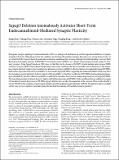Sapap3 Deletion Anomalously Activates Short-Term Endocannabinoid-Mediated Synaptic Plasticity
Author(s)
Chen, Meng; Wan, Yehong; Ade, Kristen; Ting, Jonathan; Feng, Guoping; Calakos, Nicole; ... Show more Show less
DownloadChen-June 2011-Sapap3 deletion anom.pdf (1.396Mb)
PUBLISHER_POLICY
Publisher Policy
Article is made available in accordance with the publisher's policy and may be subject to US copyright law. Please refer to the publisher's site for terms of use.
Terms of use
Metadata
Show full item recordAbstract
Retrograde synaptic signaling by endocannabinoids (eCBs) is a widespread mechanism for activity-dependent inhibition of synaptic strength in the brain. Although prevalent, the conditions for eliciting eCB-mediated synaptic depression vary among brain circuits. As yet, relatively little is known about the molecular mechanisms underlying this variation, although the initial signaling events are likely dictated by postsynaptic proteins. SAP90/PSD-95-associated proteins (SAPAPs) are a family of postsynaptic proteins unique to excitatory synapses. Using Sapap3 knock-out (KO) mice, we find that, in the absence of SAPAP3, striatal medium spiny neuron (MSN) excitatory synapses exhibit eCB-mediated synaptic depression under conditions that do not normally activate this process. The anomalous synaptic plasticity requires type 5 metabotropic glutamate receptors (mGluR5s), which we find are dysregulated in Sapap3 KO MSNs. Both surface expression and activity of mGluR5s are increased in Sapap3 KO MSNs, suggesting that enhanced mGluR5 activity may drive the anomalous synaptic plasticity. In direct support of this possibility, we find that, in wild-type (WT) MSNs, pharmacological enhancement of mGluR5 by a positive allosteric modulator is sufficient to reproduce the increased synaptic depression seen in Sapap3 KO MSNs. The same pharmacologic treatment, however, fails to elicit further depression in KO MSNs. Under conditions that are sufficient to engage eCB-mediated synaptic depression in WT MSNs, Sapap3 deletion does not alter the magnitude of the response. These results identify a role for SAPAP3 in the regulation of postsynaptic mGluRs and eCB-mediated synaptic plasticity. SAPAPs, through their effect on mGluR activity, may serve as regulatory molecules gating the threshold for inducing eCB-mediated synaptic plasticity.
Date issued
2011-06Department
Massachusetts Institute of Technology. Department of Brain and Cognitive Sciences; McGovern Institute for Brain Research at MITJournal
Journal of Neuroscience
Publisher
Society for Neuroscience
Citation
Chen, M. et al. “Sapap3 Deletion Anomalously Activates Short-Term Endocannabinoid-Mediated Synaptic Plasticity.” Journal of Neuroscience 31.26 (2011): 9563–9573. Web.
Version: Final published version
ISSN
0270-6474
1529-2401